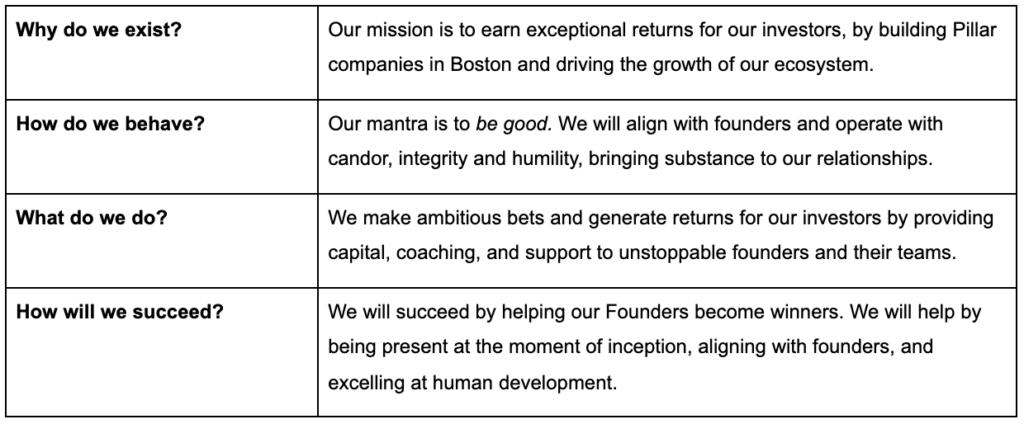Home// Articles// Starting a Company// How To: Strategic Planning
How To: Strategic Planning
 Sarah Hodges
Managing Partner at Pillar VC
Sarah Hodges
Managing Partner at Pillar VC
By Sarah Hodges, as seen in Hackernoon.
Once before we head into the new year, and then again quarterly, our team at Pillar meets to define our strategic roadmap and reassess our collective priorities. The exercise helps us focus on what matters most, but is also a consistent source of reflection and provocative discussion around what we’ve achieved, where we still have gaps, and how we need to respond to and prepare for the evolution of our space. The importance of slowing down to speed up never rings more true than when we leave these meetings.
We use an approach that my colleagues at Pluralsight introduced to me that worked well for our management team as we scaled from 250–500 employees; we’ve made a few small tweaks, but it works just as well for us as a 6-person team at Pillar.
Templates
Rocks & Pebbles
Put the rocks in first.
The pebbles will fill in the gaps.
The strategic playbook we use is centered around the concept of rocks and pebbles in a jar (watch this short video). If you put all the pebbles in first, you won’t have room for the rocks. If you put the rocks in first, the pebbles will fill in the gaps.
- Rocks = big meaningful initiatives that move the needle
- Pebbles = daily work
This framework is derived from the 7 Habits of Highly Effective People, and forces you to identify a small handful of meaningful initiatives that the team will rally around achieving each quarter. Another book that was influential in how we approached these meetings and our relationships with each other as an executive team was The Advantage, by Patrick Lencioni––also worth a read.
Mission, Vision, and Values
Your mission, vision, and values are determined once.
The boxes at the top of the page align with mission, vision and values. In theory, these should never or only rarely change. Every word matters. I’ve included ours for Pillar below

The last box is the only one that will change quarterly — what is most important now.
Themes
Themes are determined annually.
The annual themes are broad objectives for the year related to specific aspects of your business. These themes will guide your rocks each quarter; if you want to achieve them, you need to work on projects (rocks) that further their development. Examples might include broad themes like stand up marketing automation infrastructure, prove repeatable sales model, or maintain a diverse and inclusive culture as we scale.
Rocks
Rocks are determined quarterly.
Each quarter, you identify a small handful of goals or rocks that you will achieve as a team. These should be strategic initiatives that drive the business forward––the fewer the better. You want to have a few stretch goals, but you should be able to attain these goals with a concentrated effort. The more you have, the less focused you will be, and the less likely you are to achieve them. These might include specific rocks like implement a sales productivity tool, launch a new product/element of a product, or establish and testing a new channel partnership by a certain date.
Rocks should be the strategic initiatives that drive the business forward -- the fewer the better.
A couple of notes:
- Each rock should have an owner, who is responsible for reporting on progress at each weekly management meeting.
- Each rock should include explicit criteria for success––i.e. how will we know if we achieved it?––ideally quantifiable.
- During each weekly meeting, we review the status of each rock. As part of our discussion, we evaluate whether pebbles are impeding our progress, or whether there are other hurdles we need to address or tradeoffs we need to make to succeed.
The key is to make these few and meaningful (we will often challenge each other — is that a rock or a pebble?).
KPIs
KPIs are measured annually.
These are the success measures by which you will measure the progress of your business. Standard KPIs, fewer and more concrete = better.
Now, build your Rocks Dashboard
Once we have our rocks and have filled in our playbook, we put them in the Rocks Dashboard spreadsheet to track our progress. We review this every week during our team meeting.
What happens
to rocks we discuss, but
don't pursue?
What happens to rocks we discuss, but don’t pursue? We throw them in the parking lot, a list in a tab in our dashboard that we save and revisit next time. Likewise, throughout the quarter as other new ideas emerge, we stick them here for discussion next quarter.
Quarterly Planning Session
We host a one-day planning session during the last week of the quarter every quarter. We review the prior quarter’s rocks and discuss what we achieved, where we missed and why. This is in addition to reviewing the rocks on a weekly basis during management meetings.
In advance of that meeting, we ask people to make a list of potential rocks. Individual team members will often prepare short presentations or volunteer to guide a group discussion about specific potential rocks, as we shape our thinking. We then typically have a group discussion to land on final rocks by the end of the day.
Purposeful planning is an
important way to make sure your team is aligned.
Whether you use this or another framework, purposeful planning is an important way to make sure your team is aligned and is rowing in the same direction. Done right, you’ll ensure that this feeds through to every member of your team, painting a clear picture of how each person can help drive the business forward.



